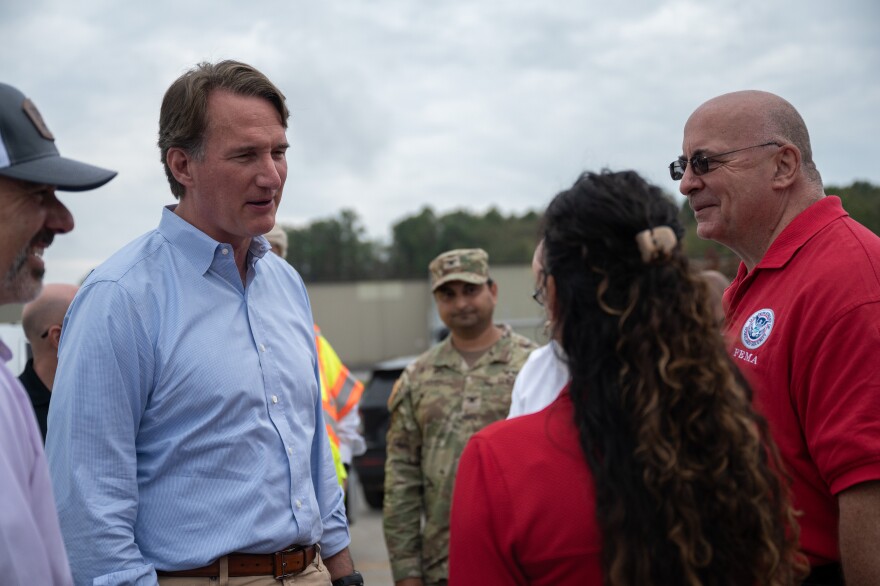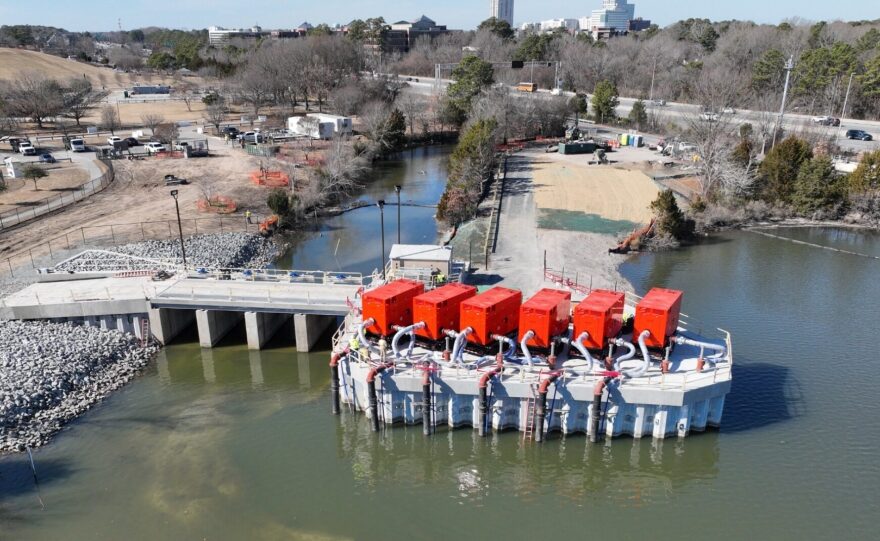Last fall, after Hurricane Helene devastated communities in North Carolina, it swept into southwest Virginia as a tropical storm, continuing its path of destruction.
Roads and bridges were torn up. Stormwaters flooded homes, businesses and thousands of farms. At least two people were killed.
After the storm, Virginia turned to the federal government for help. Gov. Glenn Youngkin requested more than $4 billion from the Federal Emergency Management Agency to aid recovery efforts.
“While this office continues to work collaboratively with our partners at all levels, the severity of these impacts highlights the significant need for accelerated federal support,” he wrote in a November letter to then-President Joe Biden.
Youngkin is now one of two sitting governors who are part of an effort by President Donald Trump to overhaul and potentially make deep cuts to the agency, which has already lost about a fifth of its workforce this year.
Trump appointed Youngkin to the FEMA Review Council, led by U.S. Homeland Security Secretary Kristi Noem. It’s tasked with assessing FEMA’s response to disasters, including reevaluating the government’s role.
The president initially pitched “getting rid of FEMA,” but has backed off from fully dismantling the agency after its recent response to deadly flooding in Texas. Noem said this month that FEMA “needs to be eliminated as it exists today and remade into a responsive agency.”
At the heart of the debate is who is responsible for helping Americans recover from natural disasters.
The Trump administration argues it should largely be the states. Youngkin agrees, to an extent.
At a May meeting of the FEMA Review Council, the governor said Virginia's prepared to shoulder a greater share of disaster recovery and response.
“The states are ready. We're ready,” Youngkin said. “We should be ready, because at the end of the day, we're responsible.”
Environmental groups, however, worry significant cuts to FEMA could severely harm communities’ ability to respond to and rebuild after natural disasters.
Twenty advocacy organizations – including Appalachian Voices, the Virginia Beach Audubon Society and Norfolk-based Wetlands Watch – recently sent a letter urging Youngkin to protect and expand federal disaster aid.
“While rebuilding after living through a devastating flood, people in need are not interested in what politicians are discussing in Washington,” the groups wrote. “They want to be able to easily apply for aid and be awarded enough funding from the taxes they pay to put their lives back together.”

When disaster strikes
State and local governments already lead emergency response around disasters.
FEMA steps in after a governor requests a formal disaster declaration, which includes a rough damage assessment. That unlocks two main sources of financial aid.
Individual assistance helps people directly, covering immediate needs, including food, water or temporary housing. Property owners can also apply for assistance to repair storm damage, though the average payout is typically only a few thousand dollars.
Public assistance gives money directly to government entities or some nonprofits to clear roadways and rebuild infrastructure. Virginia received more than $20 million after Helene last year, as well as more than $18 million in individual assistance as of this week.
In 2018, a couple of years after Hurricane Matthew devastated the Windsor Woods community in Virginia Beach, the city received about $5 million in FEMA reimbursements and used it to improve stormwater drainage in that neighborhood.
Gabrielle Walton, federal campaigns coordinator with the nonprofit Chesapeake Climate Action Network, said the commonwealth cannot afford to lose federal support, especially in smaller communities with fewer resources.
Changing climate conditions are making major storms more frequent, intense and unpredictable, she said.
“Weather events are continuing to increase in ways that our systems were not invented to respond to,” she said. “These disasters are unprecedented, often. I don't know how we can say we're ready for something with a scale we can't really imagine.”

Preventing disaster
In recent years, FEMA has looked beyond disaster response to invest in work that reduces a community’s risk before tragedy strikes.
The Building Resilient Infrastructure and Communities program, or BRIC, for example, was launched under the Biden administration through the Infrastructure Investment and Jobs Act. It awarded billions of dollars in grants nationwide for risk-reducing projects such as flood control systems and wildfire prevention.
This spring, the Trump administration ended the program, rescinding funds that had not yet been spent. That included nearly $25 million earmarked for projects in Hampton Roads, such as improvements to the Lake Meade Dam in Portsmouth.
The Hampton Roads Planning District Commission lost $200,000 that was set to help update the region’s Hazard Mitigation Plan.
FEMA requires localities to have these plans, updated every five years, to be eligible for federal disaster funding. Hampton Roads’ latest version will expire by 2027.
Virginia Sen. Mark Warner said hazard mitigation is an often-overlooked but critical piece of disaster preparedness.
“If you don’t do resilience planning, you're doomed to repeat time and again the same mistakes that lead to disasters.”
Room for reform
People on all sides of the political spectrum agree that FEMA is in need of changes, particularly in getting aid to people more quickly and with fewer bureaucratic obstacles.
Warner said FEMA’s financial calculation for aid also disadvantages rural and low-income communities. After Helene, for instance, many southwest Virginia homeowners struggled to get individual assistance because of relatively lower property values compared to other areas of the state.
That needs to change, Warner said. But he doesn’t think scaling back federal aid is the answer.
Virginia received billions in federal assistance to help rebuild the beloved Creeper Trail after Helene. “I'm not sure how the state budget could have absorbed that on its own,” Warner said.
And Helene “would have bankrupted North Carolina if they had to do this on its own.”
Youngkin has said the state’s ready to take on more responsibility, but acknowledges Virginia can’t afford the entire financial burden.
“Given state budget cycles and requirements to maintain a balanced budget, even states with the most robust emergency management are unable to self-fund disaster response to truly catastrophic disasters,” he wrote with North Carolina Gov. Josh Stein in a joint letter to Secretary Noem in April.
Through his seat on the FEMA Review Council, Youngkin has advocated for streamlining the aid process and turning to nonprofits and public-private partnerships to help compensate for a smaller federal role.
In response to a request for comment for this story, Youngkin’s office told WHRO, “the work of the FEMA Review Council is ongoing.”
A spokesperson for FEMA’s Region 3, which includes Virginia, directed WHRO to information on the agency’s website.
Trump’s review council is expected to make recommendations on how to change FEMA this fall, around the peak of the Atlantic hurricane season.


